“The goal of meditation is not to get rid of thoughts or emotions. The goal is to become more aware of your thoughts and emotions and learn how to move through them without getting stuck.”
~ Phillipe Goldin
Understanding What Meditation Is and What It Isn’t
So, your mind is full of thoughts 24 hours a day, and you cannot imagine being able to clear that crazy head. Sitting still makes you restless, and silence kind of freaks you out. I’m here to tell you that you’re not alone. Every meditator for centuries has felt that way at the beginning. We’re all born with “monkey minds.”
The key is to re-frame meditation in your mind, lower your expectations and release the pressure that comes with that word. First of all, you can meditate sitting, lying down, walking, or even doing dishes. Mindfulness can be practiced anywhere. Second of all, you can choose silence, music, or words to guide you, or a variety of all three. Third, 15 minutes is long enough to be therapeutic; you don’t need to attend meditation boot camp to get the benefits. Fourth, the goal isn’t to control your thoughts anyway, but rather to detach from them. Yes, they’ll float through your mind, but you’ll learn to watch them, and let them go by. In time, you will become acquainted with that space of “no thoughts.” Even if it’s only a few seconds at a time, it will become familiar to you, and it’s a beautiful place to visit. But even without reaching that space, spending time breathing deeply and relaxing is powerful therapy in itself.
Dr. Terry Wahls said that meditation is part of her personal practice, and also part of the Wahls Protocol she recommends to others. Meditation has become part of my healing process, too. Believe me when I say this surprised me. I always thought meditation was something I should do (even before I got sick.) However, I never expected it to become something I enjoyed doing. At rock bottom with rheumatoid arthritis, when my physical pain was highest, my emotions were flaring as well. I felt buffeted by sadness, fear and anger; to say I was overwhelmed is putting it lightly. The one thing that soothed those emotions until they dissipated, was meditation. I felt so much better afterward that I made it a daily practice. Now, I no longer have that level of pain, but I still meditate regularly for two reasons: (1) I know it supports my healing, (2) but more importantly, it’s a beautiful feeling that I want to experience every day. It’s one of the best stress management tools I know.
Would you like to hear more people with autoimmune disease share their meditation experiences, including beginners? Listen to my podcast: Meditation Healing Stories.
Check out these cool research results:
- Meditation reduces the expression of inflammatory genes (meaning less pain and illness.)
- Meditation increases stem cell production (those magic cells in the body that can become anything and are key to regenerative healing).
- Meditation reduces pain (both physical and mental).
- Meditation reduces risk of heart attack and stroke.
- Meditation reduces the symptoms of chronic health conditions.
- Meditation reduces feelings of anxiety and depression.
- Meditation literally changes your brain anatomy in positive ways: One study showed that it increases the neurological connections as well as the myelin sheath in the anterior cingulate region, a part of the brain which not only regulates your blood pressure and heart rate, but also your emotion and pain awareness as well. Another study showed growth in the hippocampus, posterior cingulate cortex, the temporo-parietal junction, and the cerebellum (areas of the brain involved in learning, memory, emotions and perspective.)
10 Ways to Meditate & Have Fun Doing It
1. Guided Meditation: If you’re new to meditation, having someone talk you through it can be very helpful.
Here are a few online samples:
- Healing Mindset: Guided Meditation – this is a meditation led by me specifically for people with autoimmune disease (12 minutes).
- Tune into the present moment – Jon Kabat-Zinn is an expert at making meditation nonthreatening (12 minutes).
Here are some CD’s I have used myself:
- Guided Meditations for Difficult Times: A Lamp in the Darkness by Jack Kornfield
- Chakra Balancing by Deepak Chopra
And here are some helpful smartphone apps:
2. Mindfulness Meditation is a way to make meditation part of daily life. The idea is to be fully present with whatever you’re doing. It can be as simple as mindfully eating, watching a river, listening to the wind, even doing dishes. Thich Nhat Hanh is a leader in the Mindfulness movement and this is what he says:
“To my mind, the idea that doing the dishes is unpleasant can occur only when you are not doing them. Once you are standing in front of the sink with your sleeves rolled up and your hands in warm water, it really is not so bad. I enjoy taking my time with each dish, being fully aware of the dish, the water, and each movement of my hands. I know that if I hurry in order to go and have a cup of tea, the time will be unpleasant and not worth living. That would be a pity, for each minute, each second of life is a miracle. The dishes themselves and the fact that I am here washing them are miracles! Each bowl I wash, each poem I compose, each time I invite a bell to sound is a miracle, each has exactly the same value.”
3. Moving Meditation: If the idea of sitting still is intimidating, yoga and tai chi are often considered forms of moving meditation.They involve deep breathing and body presence and often achieve the same healing state as sitting meditation. If you’re new to these practices, I recommend you start gently with beginner’s classes, to safely learn the forms.
4. Meditation Music: Relaxing music can help ease the transition between the stress of daily life, and the healing state of meditation. Research shows that relaxing music can reduce anxiety, lower blood pressure, and lower the heart rate. Online radio stations such as Pandora and Spotify have New Age channels, where you’ll find the quietest music. Also, as a massage therapist, I’ve become an expert at relaxing music. Here are some favorites:
- Water by Peter Kater
- Dreamer II by Michael Hoppe & Tim Wheater
5. Mantra-based Meditation: The purpose of a mantra is to give your mind something to focus on, replacing your thoughts, and giving you a path to deep relaxation. You’ve probably heard the mantra “Om” which is perhaps the most common. It is meant to signify the vibration of the universe. There are many other mantras you can use when meditating. They can be a word, a phrase or a sentence:
- Be here now
- Love
- I am
- Amen
- Every day in every way I’m getting better and better.
- I am a child of the universe. I hold its power in my heart.
- Dr. Terry Wahls recommends the mantra “soft belly” in this 5 minute beginner’s meditation: Sit comfortably in a chair. Close your eyes. Focus on the air coming into and out of your nostrils. As the air comes into your nostrils, imagine the word “soft.” As the air exits your nostrils, imagine the word “belly.”
Transcendental Meditation is the mantra meditation technique of the stars. It was created by Maharishi Mahesh Yogi, who became famous in the 60’s because the Beatles were his students. Today, if you hear Jerry Seinfeld, Ellen Degeneres, Dr. Oz and Oprah talk about meditation, they’re referring to TM as well. TM is unusual in that it requires in-class training, where you receive a specific mantra to use during your meditations from that point forward.
6. Law of Attraction Meditation: This theory says that you are a magnet attracting to you all things, via the signal you are emitting through your thoughts and feelings. In essence, what you visualize is what you get. There are two components to an LOA meditation: (1) Expressing gratitude for the blessings currently in your life, which sets an energetic tone for more blessings to come. (2) Visualize the reality you want, in great detail. If you have a chronic illness, you visualize yourself well. If you have trouble walking right now, picture yourself dancing. If it’s difficult for you to breathe, picture yourself singing. If you’re exhausted, picture yourself with boundless energy, doing physically demanding activities effortlessly.
7. Silent Meditation: This is both the simplest, and most intimidating form of meditation to many. However, it has become one of my favorites, because the silence helps amplify that space between thoughts, without filling it with other things. Here are some tips to make it less intimidating: Get comfortable any way you want. You can sit, lie down, or be semi-reclined. You can be on the floor or on a piece of furniture. You can be at home, or at a park, or sitting in your car waiting for your kids to finish soccer practice. Close your eyes, take a deep breath, and open yourself up to the silence. Thoughts will come; don’t worry about them. Pema Chodron is a gifted meditation teacher, and in this video she gives some wonderful advice for responding to thoughts that naturally arise during meditation. The answer is simple: don’t judge yourself for thinking; thoughts are a natural part of you; just return to your breath, and focus on the inhale and the exhale. Begin with just 5 minutes, and slowly work your way up to more.
8. Compassion Meditation: The Dalai Lama believes in peace through meditation, by developing our sense of compassion toward ourselves and others. He combines mindfulness with sitting meditation in his recommendations:
- Spend 5 minutes at the beginning of each day remembering we all want the same things (to be happy and be loved) and we are all connected to one another.
- Spend 5 minutes: breathing in – cherishing yourself; and breathing out – cherishing others. If you think about people you have difficulty cherishing, extend your cherishing to them anyway.
- During the day extend that attitude to everyone you meet. Practice cherishing the simplest person (clerks, attendants, etc., as well as the “important” people in your life; cherish the people you love and the people you dislike).
- Continue this practice no matter what happens or what anyone does to you.
9. Religious Meditation: Meditation is a secular practice, meaning there’s nothing inherently religious about it, but if you would like to connect it to your faith, you can certainly do so. Some form of meditation has been practiced within all religions for centuries:
- In the Catholic church, saying the rosary is a form of meditation.
- Christians of many denominations practice biblical meditation, which is the memorization of, and meditation on, specific verses of scripture.
- Some call on angels during meditation: Michael for protection, Raphael for physical healing and Zadkiel for emotional healing, to name a few.
- This Islamic meditation combines contemporary meditative practice with an awareness of Allah’s love.
- The Awakened Heart Project blends the ancient meditative techniques of Jewish contemplatives, with modern forms of meditation, to enhance the practice of “veahvta l’ray-eahchah kah-mocha – that you shall love your fellow human being as yourself. (Lev 19:18)”
10. Create Your Own: As you make meditation a regular practice in your life, you might choose to do self-guided journeys. There are infinite ways to meditate:
- When I was in a lot of pain, I relaxed, closed my eyes, breathed deeply, and pictured butterflies landing on every part of my body that hurt. I pictured them landing softly, fluttering awhile, and then lifting off again, taking my pain with them.
- My friend Sharon loves to do an affirmation alphabet. She goes through every letter and thinks up a positive word, applying that word to herself and her life: Altruism, Bliss, Creativity, Daring, Empowerment, Friendship, Grace, etc.
- My friend Teri does laughter meditation. She simply starts laughing; it doesn’t matter if it’s genuine. She explores all varieties: giggles, snorts, chuckles and guffaws, and pretty soon it does become genuine laughter. Research shows that laughter reduces pain, relieves stress and boosts healing. We should all do it more often, especially when we least feel like it.
- The possibilities are endless. The only constants are to get in a comfortable position, breathe deeply, relax, and either go to a place of no thought, or one filled with positive imagery.
Resources

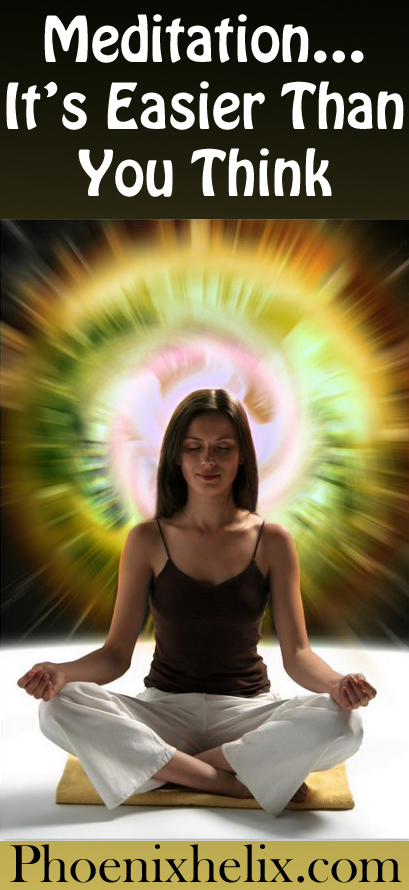
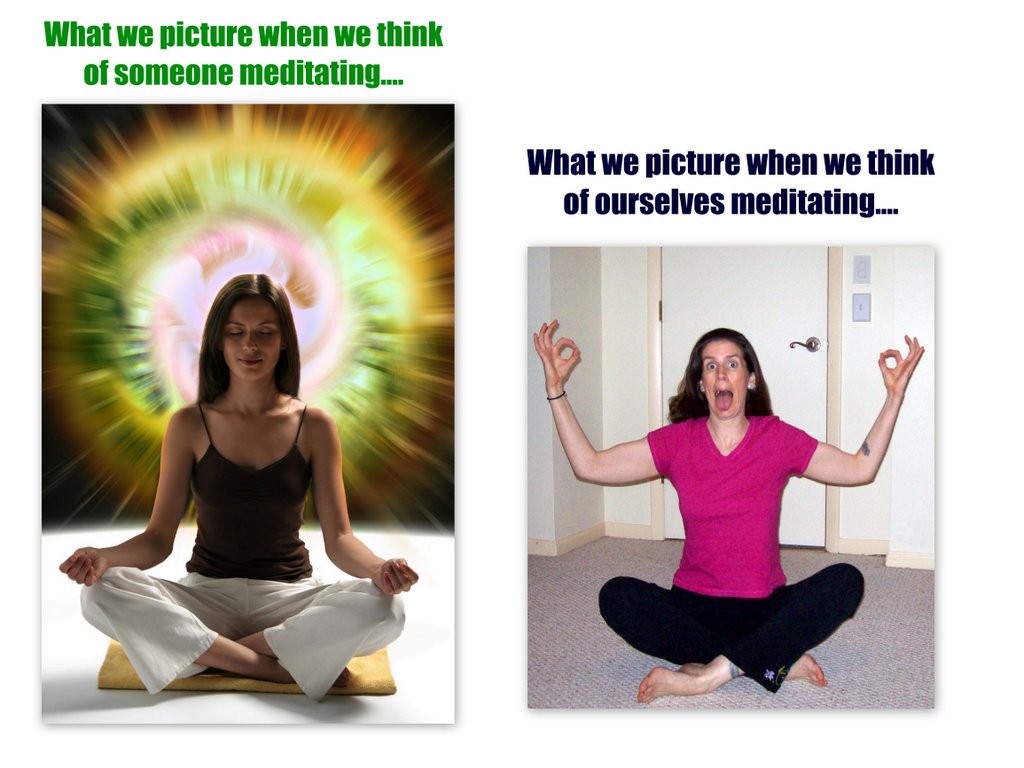
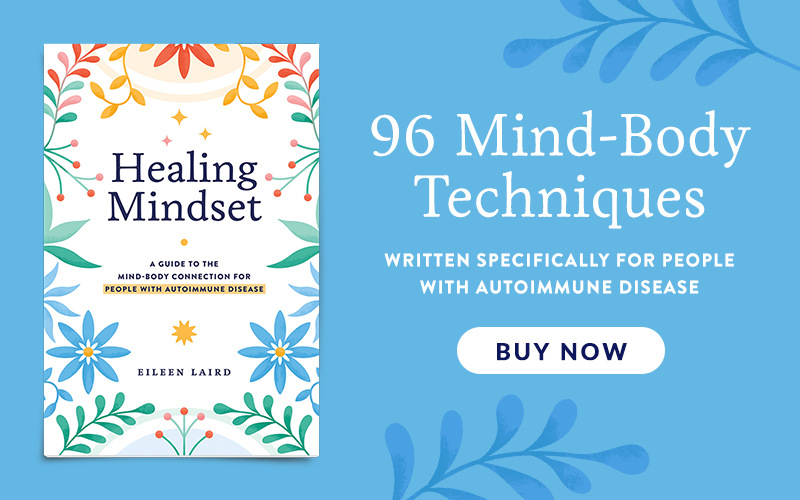
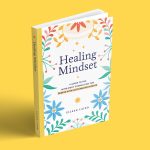


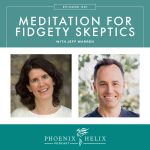



This was so well done! I truly feel encouraged to keep practicing.
My one mantra word by the way id peaceful.
And when I was my dishes I thank the dishes for the work they do – helping me eat more efficiently and gracefully.
This might be my very favorite article on meditation I have ever read.
Maybe you can submit it to tiny buddha or mind body green?
I will pass on in my facebook page.
Namaste, Rita
What a lovely compliment. Thanks, Rita! I love that you thank your dishes. I might try doing that myself.
Hi! Thank you for all this information you provided. The Law of Attraction meditation is something I would like to try. The link to the video doesn’t work. Do you know of any others you could recommend?
Hi Janet. I’m sorry, I don’t. If you find one you like, please let me know.
Eileen – thanks for this. Mindfulness is one area I personally struggle with (tai chi seems to be my best to date). 🙂
I think tai chi is a beautiful form of meditation. I just interviewed Terry Wahls for an upcoming podcast and she teaches a 1 minute meditation technique “live” as part of the interview. It’s the same thing she teaches her patients. Even after 1 minute, I felt a shift, mentally and physically.
Thank you so much for this list. I have been wanting to try meditation for a while and felt overwhelmed by all the different types and various costs associated. Your presentation of the information is very user friendly to this novice. Thanks again
I’m so glad, Cynthia. Enjoy the experience.
This is such a thoughtful, well written post! Thank you, thank you!
First off, I personally use meditation to manage stress. I started many years ago, around the time I started yoga. But my idea of meditation has evolved over the years. I broke free of what I thought it was supposed to me (the fantasy of meditation) and found what works best for me. It’s my number 1 stress reduction technique. What I do is a silent mediation that incorporates positive imagery and positive affirmations. It’s about letting the good and positive in to counter act the negative we are bombarded with. I feel the negative is what is most draining, oh and stress of course, but I do other things for the stress reduction (to stop rumination and worry, etc).
Overall, reducing stress is one of my most effective medicines in my fight with Crohns Disease. Anxiety and stress can throw me into a flare very quickly. So I keep my immune system strong by being mindful about my stress level and being very proactive about controlling it.
I thank you again for this great post. I am sharing on FB today and I hope it makes its way around the web, as people will really benefit from this information.
Be Well,
–Amber
P.S. I am featuring this post on AFW tonight. 🙂
Thanks for sharing my post on FB & AFW! I love how you said this: “I keep my immune system strong by being mindful about my stress level and being very proactive about controlling it.” Wiser words have never been spoken.
Well, thank you for a great post and great blog. I’m tickled you described my words as “wise.” 🙂 You made my night.
I am so happy to have all these meditation resources in one place! I often start a practice and then will go days or weeks without it, so it hasn’t become a “good habit” yet. I do, however, take time throughout the day to just focus on my breathing. I have an alarm set on my iPhone for once per hour with the Harp sound and the message “Breathe.” I also use words like “Gentle breath in… relaxing breath out” because I caught myself rushing through it.
Karen, you are awesome! I love it all: the alarm, the harp, Breathe, and your own awareness to slow down. Thanks for sharing.
Thank you for this! I really needed it. I’ve been thinking about getting into meditation for while, but it’s always so intimidating. This really breaks it down and I see that I already practice certain mindful meditations during the day, so maybe it’s not so hard to add more.
You’re welcome, Amy. Enjoy your experiments. Meditation can actually be fun!
Very nice of you to provide options that appeal to a variety of mindsets and beliefs! Thanks.
Thanks, Jaime! I just got back from a meditative walk. Listening to the sounds of the river, feeling the wind blow through my hair, remembering that snow has a smell, and saying “thank you” with each footstep, it took me out of my swirling mind to a much better place.